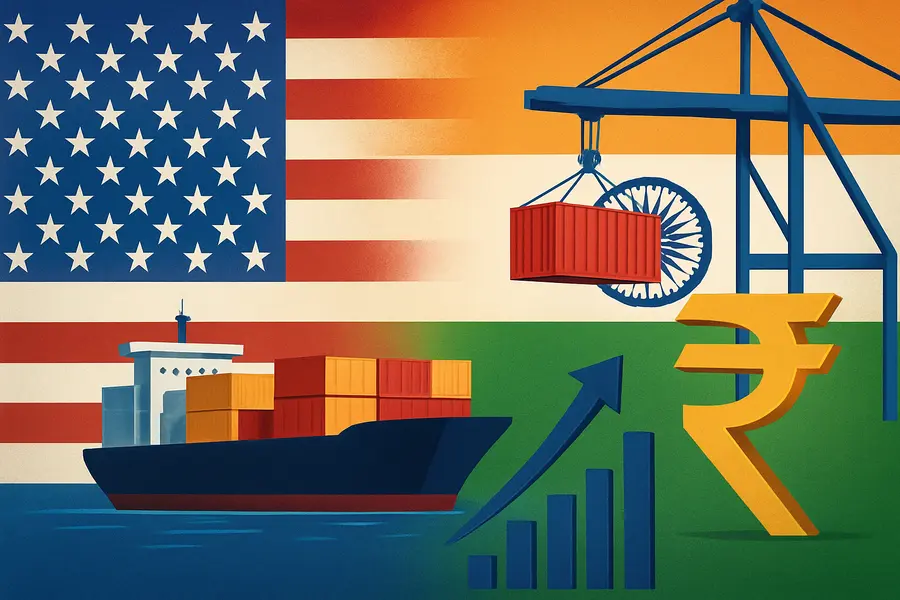Quick Takeaways
- U.S. tariffs = higher import taxes that make Indian goods costlier and less competitive in American markets.
- India–U.S. trade crossed $120 billion in 2024, but key export sectors like textiles, steel, pharma, and auto components face rising challenges.
- Employment and MSMEs in export-heavy regions are the most vulnerable to trade disruptions.
- Rupee pressure and inflation may follow if export earnings decline.
- Despite short-term losses, India’s IT and services sectors remain stable and continue to balance the trade equation.
- Diversifying exports to ASEAN, Africa, and Europe can reduce overreliance on the U.S. market.
- Policies like Make in India, Atmanirbhar Bharat, and upcoming FTAs are key tools to offset tariff impacts.
- Experts predict India’s GDP will stay resilient around 6.5–6.7%, driven by domestic demand and innovation.
- The long-term solution: focus on value-added exports, sustainability, and global competitiveness.
- Tariffs may test India’s strength—but they also push it toward a smarter, more self-reliant trade future.

What Impact Will US Tariffs Have on Indian Exports and Economy? — Decoded
Trade between India and the United States has long been a story of partnership and opportunity.
From software services to spices, Indian exports cater to America’s vast and diverse market. But when Washington raises tariffs—essentially extra taxes on imported goods—the ripple can reach all the way to Indian factories, ports, and job markets.
Recently, new U.S. tariff measures aimed at protecting domestic industries have reignited concerns about how global supply chains and developing economies like India will respond.
For exporters and policymakers alike, this isn’t just about economics—it’s about adapting to an evolving trade order where politics, competitiveness, and national interests intersect.
So, what do these tariffs really mean for India? Will they hurt, or could they push the economy toward greater self-reliance and innovation?
Let’s decode the complex world of tariffs and explore what lies ahead for Indian exports and the broader economy.
Understanding US Tariffs
In simple terms, a tariff is a tax that one country places on goods imported from another. The United States uses tariffs to make foreign goods costlier, encouraging Americans to buy locally produced alternatives.
While that sounds like a patriotic move, it often sparks global tension—because one nation’s “protection” can become another’s “problem.”
There are generally two kinds of tariffs: protective tariffs, designed to shield domestic industries from cheaper imports, and retaliatory tariffs, used as a counter-move when another country imposes trade restrictions.
The U.S. has a long history of using both. For instance, during the 2018–2019 trade war with China, American tariffs triggered global disruptions and indirectly impacted Indian exporters too.
Today, as the U.S. seeks to rebuild critical manufacturing and reduce dependence on foreign supply chains, certain Indian exports—like steel, textiles, and pharmaceuticals—might face fresh tariff barriers.
However, these actions are rarely one-sided. India often responds diplomatically, negotiating through trade forums and bilateral talks.
Understanding these tariffs isn’t just about economics—it’s about geopolitics and global power balance. Each tariff decision sends signals about how nations perceive fairness, competitiveness, and strategic dependence. And for India, decoding those signals early is key to staying ahead in global trade.
India–US Trade Snapshot (2024–2025)
Trade between India and the United States has grown into one of the strongest economic partnerships in the world.
By 2024, the U.S. had become India’s largest trading partner, with total trade crossing $120 billion, reflecting the depth of their commercial ties.
India’s exports to the U.S. range from diamonds, textiles, and pharmaceuticals to IT services, machinery, and auto components—a mix that highlights both traditional strengths and modern innovation.
Among these, pharmaceuticals and IT services stand out as major success stories. Indian pharma companies supply affordable generic drugs to millions of Americans, while Indian IT firms manage backend systems for top U.S. corporations.
Meanwhile, textiles and engineering goods continue to drive employment in export hubs like Gujarat, Tamil Nadu, and Maharashtra.
However, the relationship isn’t without friction. The U.S. occasionally raises tariff barriers or imposes tighter quality standards, especially on steel, chemicals, and solar components. Such moves can raise production costs for Indian exporters and affect their competitiveness.
On the flip side, India’s imports from the U.S.—including crude oil, aircraft parts, and advanced technologies—help balance trade and boost domestic capacity.
The two countries are also negotiating new frameworks under the Indo-Pacific Economic Framework (IPEF) and potential FTA talks, aiming to reduce friction and encourage smoother trade.
The India–U.S. trade bond is both deep and delicate—built on opportunity, but always tested by policy shifts.
Key Sectors That May Be Hit Hard
When U.S. tariffs rise, their shockwaves travel unevenly across India’s diverse export sectors.
Some industries feel the pinch immediately, while others face indirect effects like reduced demand or higher compliance costs. Here’s how these key sectors could be impacted:
1. Textiles and Apparel
India’s textile exports to the U.S. face rising competition from tariff-free countries like Bangladesh and Vietnam. Even a small tariff increase can make Indian garments costlier, hurting profit margins and employment in clusters such as Tiruppur and Surat. Exporters may need to innovate with value-added fabrics.
2. Steel and Aluminum
The U.S. often imposes protective tariffs on steel and aluminum to support local manufacturers. For India, these barriers reduce export volumes and force companies to explore alternative markets. The sector also faces higher input costs and supply disruptions, impacting domestic infrastructure and manufacturing growth.
3. Pharmaceuticals
Although Indian generic drugs enjoy strong U.S. demand, new tariff or regulatory measures could increase costs. Stricter FDA compliance and patent-related rules act as non-tariff barriers. Indian pharma firms may need to invest more in R&D and quality assurance to retain their global competitiveness.
4. Gems and Jewelry
India exports a large share of polished diamonds and jewelry to the U.S. Tariff hikes could reduce retail demand, especially during festive seasons. High gold prices and dollar fluctuations further complicate margins, prompting exporters to focus on luxury niches and custom design offerings.
5. Auto Components
U.S. tariffs on auto imports can indirectly hit Indian component suppliers linked to American and global automobile chains. Reduced export orders affect MSMEs, especially in Pune and Chennai. To counter this, India may push electric vehicle parts and high-precision manufacturing exports.
6. Chemicals and Plastics
India’s chemical exports face price pressure when tariffs rise on intermediates and specialty chemicals. The U.S. demand for eco-friendly materials is growing, but meeting those sustainability standards adds costs. Indian firms must modernize production and comply with environmental norms to stay competitive.
7. Information Technology Services
While not directly tariffed, the IT sector can be affected by broader U.S. protectionism. Visa restrictions, data localization norms, and preference for domestic hiring can limit growth. Indian firms are countering this by setting up local delivery centers and hiring U.S.-based talent.
8. Renewable Energy Equipment
U.S. tariffs on imported solar modules and components affect Indian renewable energy exporters. Higher prices weaken competitiveness against American-made panels. However, India’s growing green manufacturing base could turn this challenge into an opportunity by boosting domestic demand and self-reliant clean energy innovation.
Ripple Effects of US Tariffs on the Indian Economy
Tariffs don’t just hit exporters—they ripple through the entire economy. When U.S. duties make Indian goods costlier, demand drops, leading to slower factory output, lower employment, and reduced earnings for small and medium enterprises that depend heavily on exports.
Sectors like textiles, steel, and auto components employ millions, so even minor trade disruptions can trigger job losses and wage stagnation in industrial hubs.
A dip in export earnings also affects India’s foreign exchange reserves, putting pressure on the rupee, which can lead to imported inflation—making everyday goods like oil or electronics costlier for consumers.
Additionally, reduced export competitiveness shrinks tax revenues and investment confidence, slowing overall GDP growth. However, the impact is uneven: service sectors such as IT may remain relatively stable, cushioning the blow.
Policymakers often respond through export incentives, interest subsidies, or bilateral negotiations to ease barriers.
In the long run, these challenges may push India to diversify export markets, move up the value chain, and strengthen domestic manufacturing.
While U.S. tariffs may not derail India’s economic growth, they do test its adaptability and highlight the urgent need to future-proof trade through innovation and market resilience.
Silver Linings & Adaptive Strategies
Every trade challenge carries a hidden opportunity, and U.S. tariffs are no exception. For India, they serve as a wake-up call to diversify exports, strengthen self-reliance, and climb the global value chain.
By targeting new markets in ASEAN, Africa, and the EU, Indian exporters can reduce dependence on the U.S. while tapping fast-growing economies.
Government initiatives like Make in India and Atmanirbhar Bharat are also helping domestic industries upgrade technology and improve competitiveness.
Exporters are shifting focus toward value-added products, sustainable manufacturing, and digital trade channels that reduce costs and attract global buyers.
At the diplomatic level, India continues to pursue free trade agreements (FTAs) with key partners, including the UK, EU, and Australia, to secure better market access.
In essence, while tariffs test India’s resilience, they also push it to innovate, explore new frontiers, and emerge stronger in a rapidly changing global trade ecosystem.
Expert Insights and Economic Forecasts
Economists view the current tariff developments as both a short-term hurdle and a long-term restructuring phase for India’s trade. According to recent WTO and IMF assessments, higher U.S. import duties could trim India’s export growth by 1–1.5% annually if left unaddressed. However, India’s growing service exports and digital trade are expected to balance part of that loss.
Experts at NITI Aayog suggest that India’s adaptability—through supply chain diversification and increased local production—can offset much of the tariff shock within two to three years.
The RBI Monetary Policy Report (Oct 2025) shows that RBI revised its GDP growth forecast for FY 2025-26 upward to 6.8 % (from 6.5 %). Economic Times also reported that RBI’s Monetary Policy Committee revised the FY26 forecast to 6.8 %.
Some forecasts by private institutions (like Deloitte) estimate a growth range of 6.4%–6.7% based on domestic demand and capital investments.
Industry leaders emphasize innovation and compliance as key to survival. For instance, upgrading product quality, adopting green manufacturing, and using trade intelligence tools can help exporters stay competitive despite rising global protectionism.
While U.S. tariffs create temporary turbulence, most analysts agree India’s export engine remains strong, provided it continues reforming and modernizing its trade ecosystem.
Conclusion: The Road Ahead
The story of India’s trade journey with the U.S. is one of resilience amid shifting global tides.
Tariffs may slow certain export sectors, but they also challenge India to innovate, diversify, and move up the value chain.
The short-term pain of reduced competitiveness could, in time, fuel smarter manufacturing, stronger trade diplomacy, and broader market outreach.
By leveraging technology, improving logistics, and forging new trade alliances, India can turn these external shocks into strategic advantages.
The goal is not merely to withstand tariffs, but to evolve into a more self-reliant, globally trusted export powerhouse.
As global trade grows increasingly unpredictable, India’s best defense is adaptability.
With the right balance of policy reforms, innovation, and partnership, the impact of U.S. tariffs can be managed—and even transformed—into momentum for a more sustainable and future-ready economy.





